Developing Cultural Competence: Aboriginal and Torres Strait Islander People
VerifiedAdded on 2022/12/26
|11
|3221
|71
AI Summary
This report focuses on developing cultural competencies and explores the Aboriginal and Torres Strait Islander people, their history, cultural identity, and the importance of cultural awareness and sensitivity. It also discusses the impact of the Stolen Generation and ways to support Aboriginal and Torres Strait Islander families in education and care services.
Contribute Materials
Your contribution can guide someone’s learning journey. Share your
documents today.
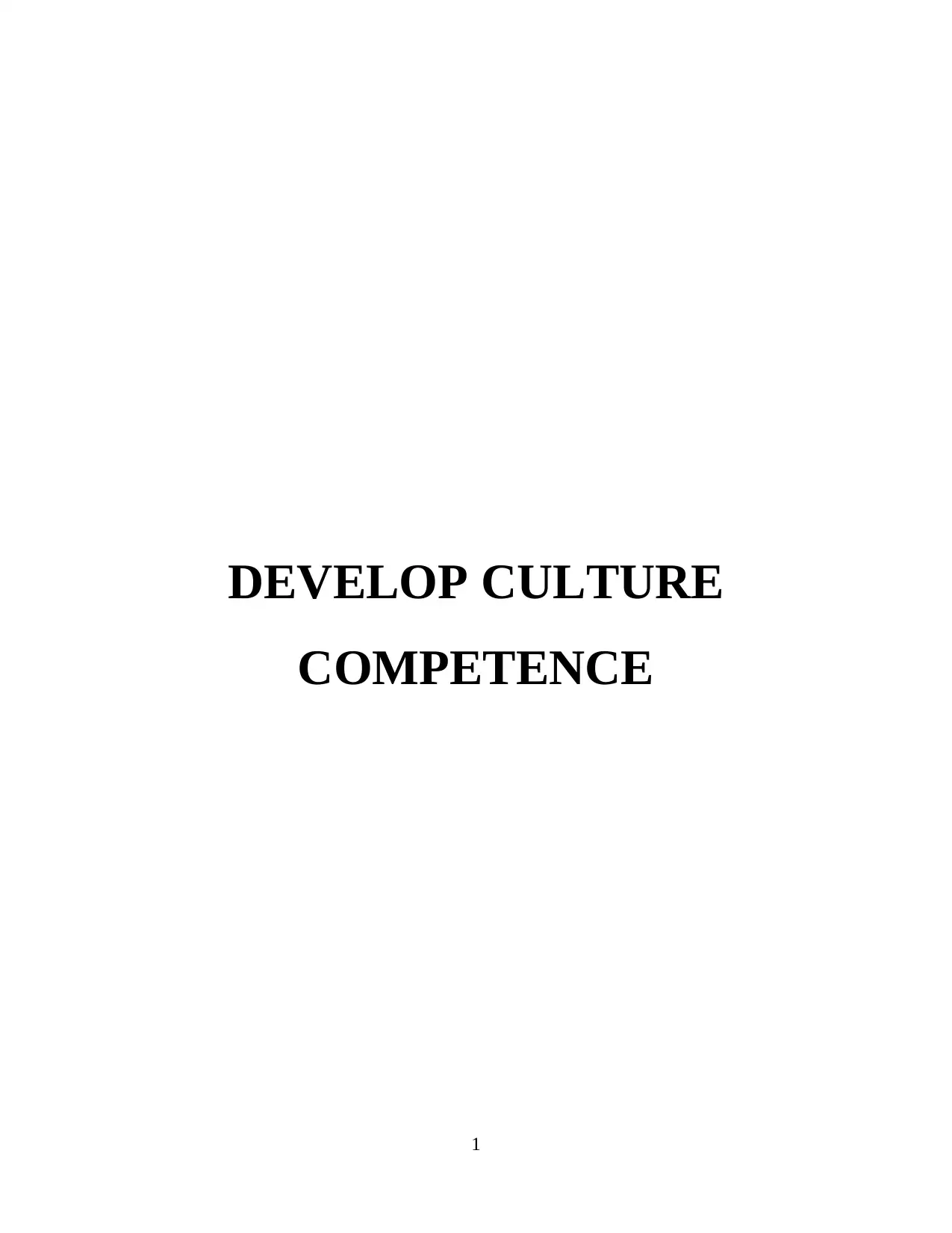
DEVELOP CULTURE
COMPETENCE
1
COMPETENCE
1
Secure Best Marks with AI Grader
Need help grading? Try our AI Grader for instant feedback on your assignments.
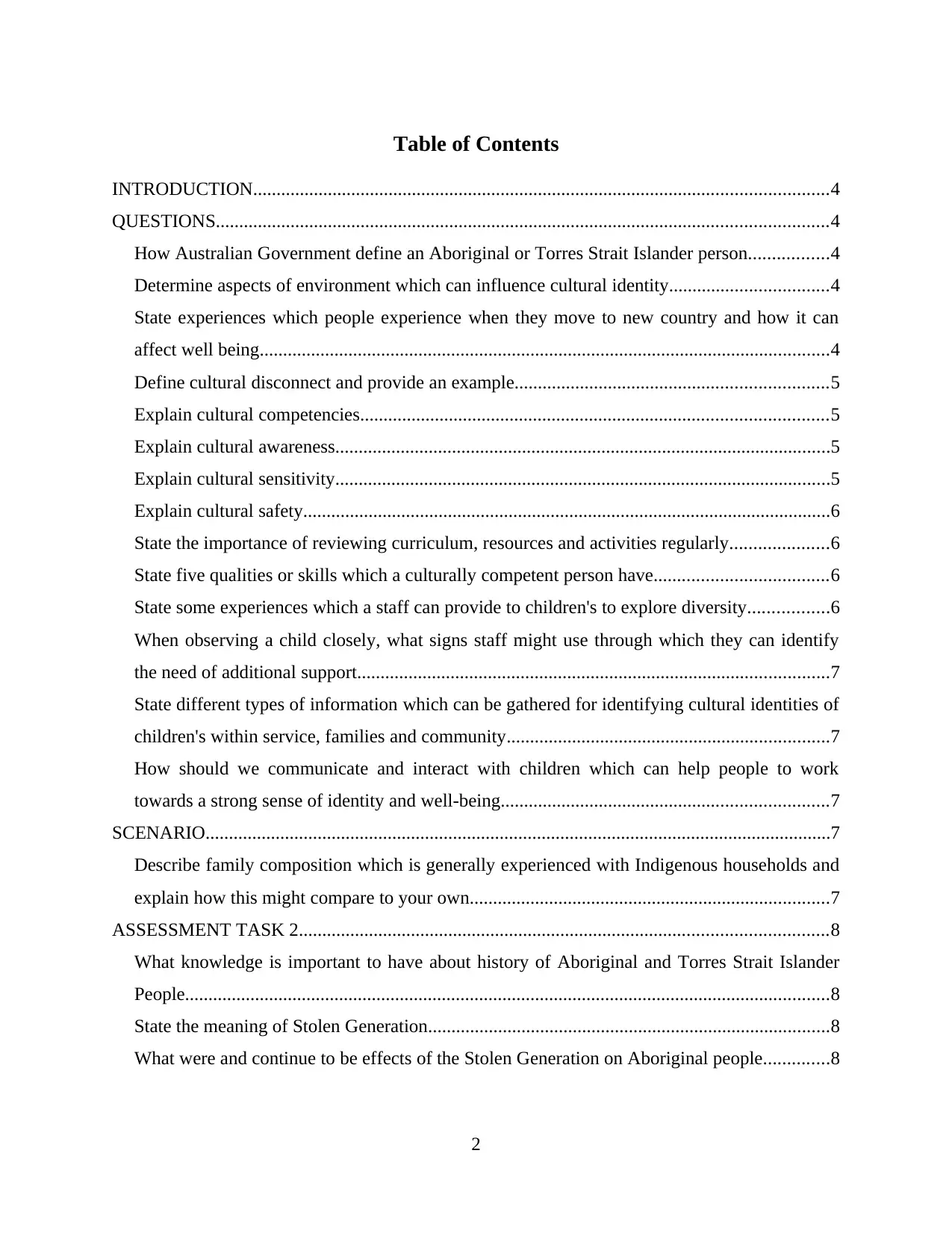
Table of Contents
INTRODUCTION...........................................................................................................................4
QUESTIONS...................................................................................................................................4
How Australian Government define an Aboriginal or Torres Strait Islander person.................4
Determine aspects of environment which can influence cultural identity..................................4
State experiences which people experience when they move to new country and how it can
affect well being..........................................................................................................................4
Define cultural disconnect and provide an example...................................................................5
Explain cultural competencies....................................................................................................5
Explain cultural awareness..........................................................................................................5
Explain cultural sensitivity..........................................................................................................5
Explain cultural safety.................................................................................................................6
State the importance of reviewing curriculum, resources and activities regularly.....................6
State five qualities or skills which a culturally competent person have.....................................6
State some experiences which a staff can provide to children's to explore diversity.................6
When observing a child closely, what signs staff might use through which they can identify
the need of additional support.....................................................................................................7
State different types of information which can be gathered for identifying cultural identities of
children's within service, families and community.....................................................................7
How should we communicate and interact with children which can help people to work
towards a strong sense of identity and well-being......................................................................7
SCENARIO......................................................................................................................................7
Describe family composition which is generally experienced with Indigenous households and
explain how this might compare to your own.............................................................................7
ASSESSMENT TASK 2.................................................................................................................8
What knowledge is important to have about history of Aboriginal and Torres Strait Islander
People..........................................................................................................................................8
State the meaning of Stolen Generation......................................................................................8
What were and continue to be effects of the Stolen Generation on Aboriginal people..............8
2
INTRODUCTION...........................................................................................................................4
QUESTIONS...................................................................................................................................4
How Australian Government define an Aboriginal or Torres Strait Islander person.................4
Determine aspects of environment which can influence cultural identity..................................4
State experiences which people experience when they move to new country and how it can
affect well being..........................................................................................................................4
Define cultural disconnect and provide an example...................................................................5
Explain cultural competencies....................................................................................................5
Explain cultural awareness..........................................................................................................5
Explain cultural sensitivity..........................................................................................................5
Explain cultural safety.................................................................................................................6
State the importance of reviewing curriculum, resources and activities regularly.....................6
State five qualities or skills which a culturally competent person have.....................................6
State some experiences which a staff can provide to children's to explore diversity.................6
When observing a child closely, what signs staff might use through which they can identify
the need of additional support.....................................................................................................7
State different types of information which can be gathered for identifying cultural identities of
children's within service, families and community.....................................................................7
How should we communicate and interact with children which can help people to work
towards a strong sense of identity and well-being......................................................................7
SCENARIO......................................................................................................................................7
Describe family composition which is generally experienced with Indigenous households and
explain how this might compare to your own.............................................................................7
ASSESSMENT TASK 2.................................................................................................................8
What knowledge is important to have about history of Aboriginal and Torres Strait Islander
People..........................................................................................................................................8
State the meaning of Stolen Generation......................................................................................8
What were and continue to be effects of the Stolen Generation on Aboriginal people..............8
2
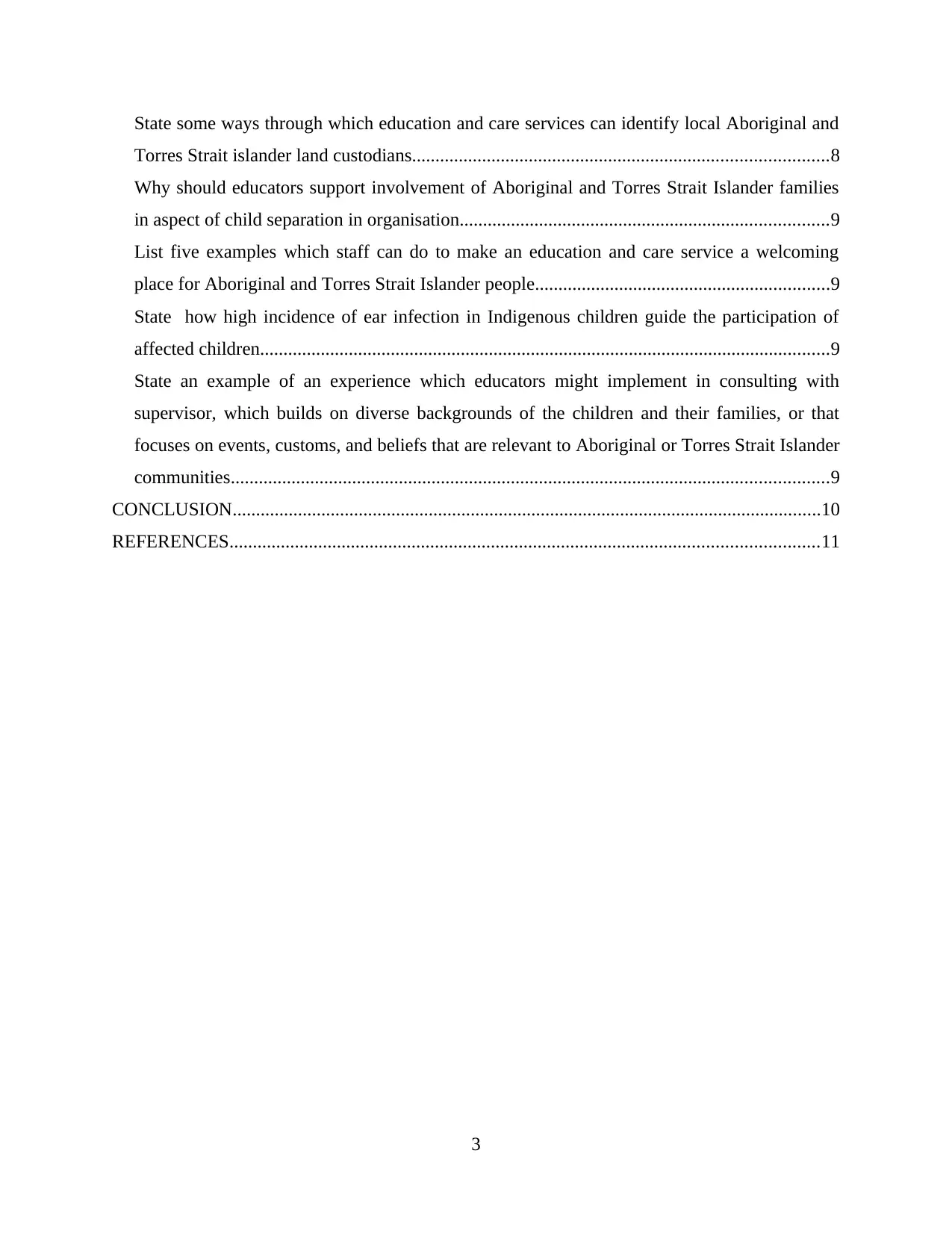
State some ways through which education and care services can identify local Aboriginal and
Torres Strait islander land custodians.........................................................................................8
Why should educators support involvement of Aboriginal and Torres Strait Islander families
in aspect of child separation in organisation...............................................................................9
List five examples which staff can do to make an education and care service a welcoming
place for Aboriginal and Torres Strait Islander people...............................................................9
State how high incidence of ear infection in Indigenous children guide the participation of
affected children..........................................................................................................................9
State an example of an experience which educators might implement in consulting with
supervisor, which builds on diverse backgrounds of the children and their families, or that
focuses on events, customs, and beliefs that are relevant to Aboriginal or Torres Strait Islander
communities................................................................................................................................9
CONCLUSION..............................................................................................................................10
REFERENCES..............................................................................................................................11
3
Torres Strait islander land custodians.........................................................................................8
Why should educators support involvement of Aboriginal and Torres Strait Islander families
in aspect of child separation in organisation...............................................................................9
List five examples which staff can do to make an education and care service a welcoming
place for Aboriginal and Torres Strait Islander people...............................................................9
State how high incidence of ear infection in Indigenous children guide the participation of
affected children..........................................................................................................................9
State an example of an experience which educators might implement in consulting with
supervisor, which builds on diverse backgrounds of the children and their families, or that
focuses on events, customs, and beliefs that are relevant to Aboriginal or Torres Strait Islander
communities................................................................................................................................9
CONCLUSION..............................................................................................................................10
REFERENCES..............................................................................................................................11
3
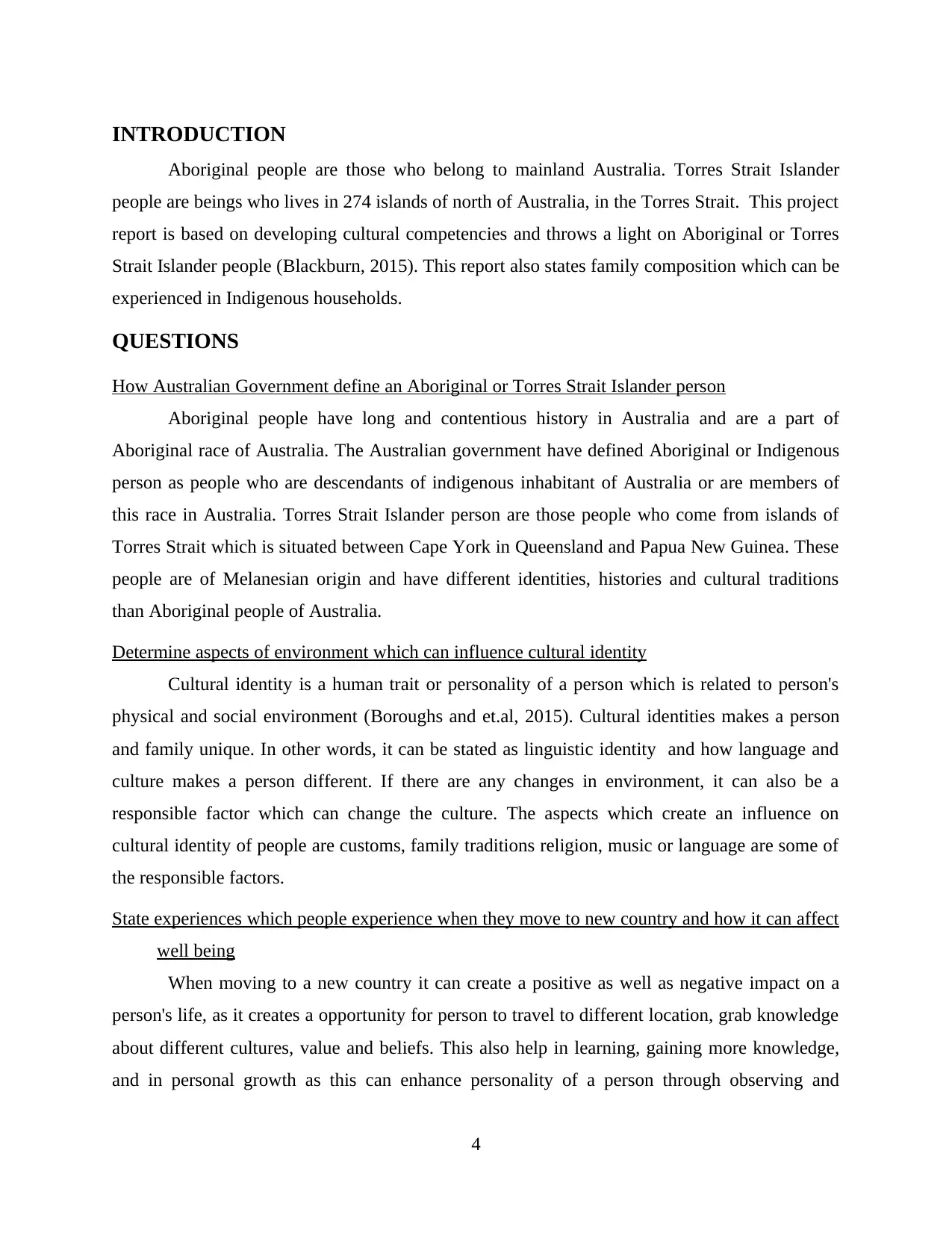
INTRODUCTION
Aboriginal people are those who belong to mainland Australia. Torres Strait Islander
people are beings who lives in 274 islands of north of Australia, in the Torres Strait. This project
report is based on developing cultural competencies and throws a light on Aboriginal or Torres
Strait Islander people (Blackburn, 2015). This report also states family composition which can be
experienced in Indigenous households.
QUESTIONS
How Australian Government define an Aboriginal or Torres Strait Islander person
Aboriginal people have long and contentious history in Australia and are a part of
Aboriginal race of Australia. The Australian government have defined Aboriginal or Indigenous
person as people who are descendants of indigenous inhabitant of Australia or are members of
this race in Australia. Torres Strait Islander person are those people who come from islands of
Torres Strait which is situated between Cape York in Queensland and Papua New Guinea. These
people are of Melanesian origin and have different identities, histories and cultural traditions
than Aboriginal people of Australia.
Determine aspects of environment which can influence cultural identity
Cultural identity is a human trait or personality of a person which is related to person's
physical and social environment (Boroughs and et.al, 2015). Cultural identities makes a person
and family unique. In other words, it can be stated as linguistic identity and how language and
culture makes a person different. If there are any changes in environment, it can also be a
responsible factor which can change the culture. The aspects which create an influence on
cultural identity of people are customs, family traditions religion, music or language are some of
the responsible factors.
State experiences which people experience when they move to new country and how it can affect
well being
When moving to a new country it can create a positive as well as negative impact on a
person's life, as it creates a opportunity for person to travel to different location, grab knowledge
about different cultures, value and beliefs. This also help in learning, gaining more knowledge,
and in personal growth as this can enhance personality of a person through observing and
4
Aboriginal people are those who belong to mainland Australia. Torres Strait Islander
people are beings who lives in 274 islands of north of Australia, in the Torres Strait. This project
report is based on developing cultural competencies and throws a light on Aboriginal or Torres
Strait Islander people (Blackburn, 2015). This report also states family composition which can be
experienced in Indigenous households.
QUESTIONS
How Australian Government define an Aboriginal or Torres Strait Islander person
Aboriginal people have long and contentious history in Australia and are a part of
Aboriginal race of Australia. The Australian government have defined Aboriginal or Indigenous
person as people who are descendants of indigenous inhabitant of Australia or are members of
this race in Australia. Torres Strait Islander person are those people who come from islands of
Torres Strait which is situated between Cape York in Queensland and Papua New Guinea. These
people are of Melanesian origin and have different identities, histories and cultural traditions
than Aboriginal people of Australia.
Determine aspects of environment which can influence cultural identity
Cultural identity is a human trait or personality of a person which is related to person's
physical and social environment (Boroughs and et.al, 2015). Cultural identities makes a person
and family unique. In other words, it can be stated as linguistic identity and how language and
culture makes a person different. If there are any changes in environment, it can also be a
responsible factor which can change the culture. The aspects which create an influence on
cultural identity of people are customs, family traditions religion, music or language are some of
the responsible factors.
State experiences which people experience when they move to new country and how it can affect
well being
When moving to a new country it can create a positive as well as negative impact on a
person's life, as it creates a opportunity for person to travel to different location, grab knowledge
about different cultures, value and beliefs. This also help in learning, gaining more knowledge,
and in personal growth as this can enhance personality of a person through observing and
4
Secure Best Marks with AI Grader
Need help grading? Try our AI Grader for instant feedback on your assignments.
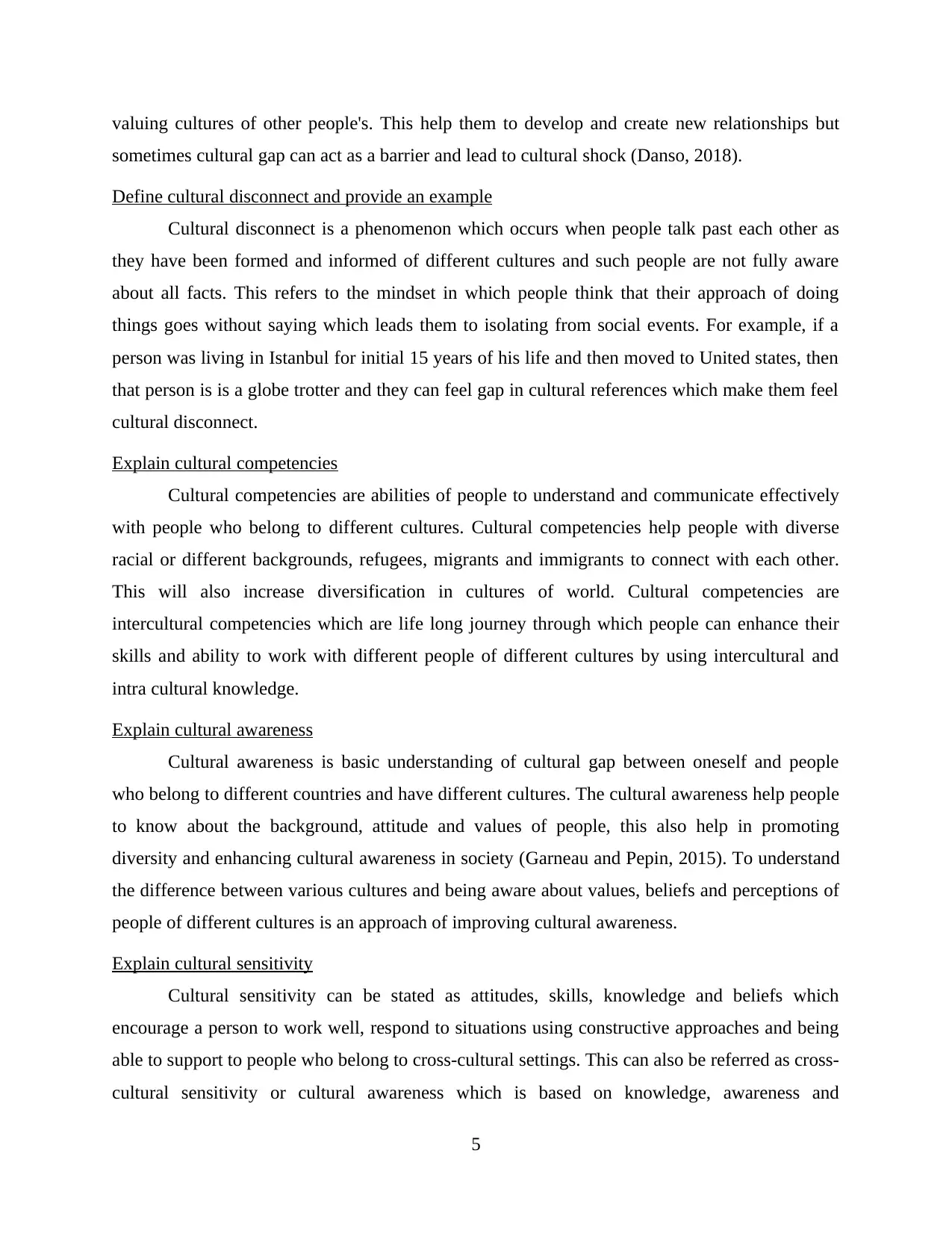
valuing cultures of other people's. This help them to develop and create new relationships but
sometimes cultural gap can act as a barrier and lead to cultural shock (Danso, 2018).
Define cultural disconnect and provide an example
Cultural disconnect is a phenomenon which occurs when people talk past each other as
they have been formed and informed of different cultures and such people are not fully aware
about all facts. This refers to the mindset in which people think that their approach of doing
things goes without saying which leads them to isolating from social events. For example, if a
person was living in Istanbul for initial 15 years of his life and then moved to United states, then
that person is is a globe trotter and they can feel gap in cultural references which make them feel
cultural disconnect.
Explain cultural competencies
Cultural competencies are abilities of people to understand and communicate effectively
with people who belong to different cultures. Cultural competencies help people with diverse
racial or different backgrounds, refugees, migrants and immigrants to connect with each other.
This will also increase diversification in cultures of world. Cultural competencies are
intercultural competencies which are life long journey through which people can enhance their
skills and ability to work with different people of different cultures by using intercultural and
intra cultural knowledge.
Explain cultural awareness
Cultural awareness is basic understanding of cultural gap between oneself and people
who belong to different countries and have different cultures. The cultural awareness help people
to know about the background, attitude and values of people, this also help in promoting
diversity and enhancing cultural awareness in society (Garneau and Pepin, 2015). To understand
the difference between various cultures and being aware about values, beliefs and perceptions of
people of different cultures is an approach of improving cultural awareness.
Explain cultural sensitivity
Cultural sensitivity can be stated as attitudes, skills, knowledge and beliefs which
encourage a person to work well, respond to situations using constructive approaches and being
able to support to people who belong to cross-cultural settings. This can also be referred as cross-
cultural sensitivity or cultural awareness which is based on knowledge, awareness and
5
sometimes cultural gap can act as a barrier and lead to cultural shock (Danso, 2018).
Define cultural disconnect and provide an example
Cultural disconnect is a phenomenon which occurs when people talk past each other as
they have been formed and informed of different cultures and such people are not fully aware
about all facts. This refers to the mindset in which people think that their approach of doing
things goes without saying which leads them to isolating from social events. For example, if a
person was living in Istanbul for initial 15 years of his life and then moved to United states, then
that person is is a globe trotter and they can feel gap in cultural references which make them feel
cultural disconnect.
Explain cultural competencies
Cultural competencies are abilities of people to understand and communicate effectively
with people who belong to different cultures. Cultural competencies help people with diverse
racial or different backgrounds, refugees, migrants and immigrants to connect with each other.
This will also increase diversification in cultures of world. Cultural competencies are
intercultural competencies which are life long journey through which people can enhance their
skills and ability to work with different people of different cultures by using intercultural and
intra cultural knowledge.
Explain cultural awareness
Cultural awareness is basic understanding of cultural gap between oneself and people
who belong to different countries and have different cultures. The cultural awareness help people
to know about the background, attitude and values of people, this also help in promoting
diversity and enhancing cultural awareness in society (Garneau and Pepin, 2015). To understand
the difference between various cultures and being aware about values, beliefs and perceptions of
people of different cultures is an approach of improving cultural awareness.
Explain cultural sensitivity
Cultural sensitivity can be stated as attitudes, skills, knowledge and beliefs which
encourage a person to work well, respond to situations using constructive approaches and being
able to support to people who belong to cross-cultural settings. This can also be referred as cross-
cultural sensitivity or cultural awareness which is based on knowledge, awareness and
5
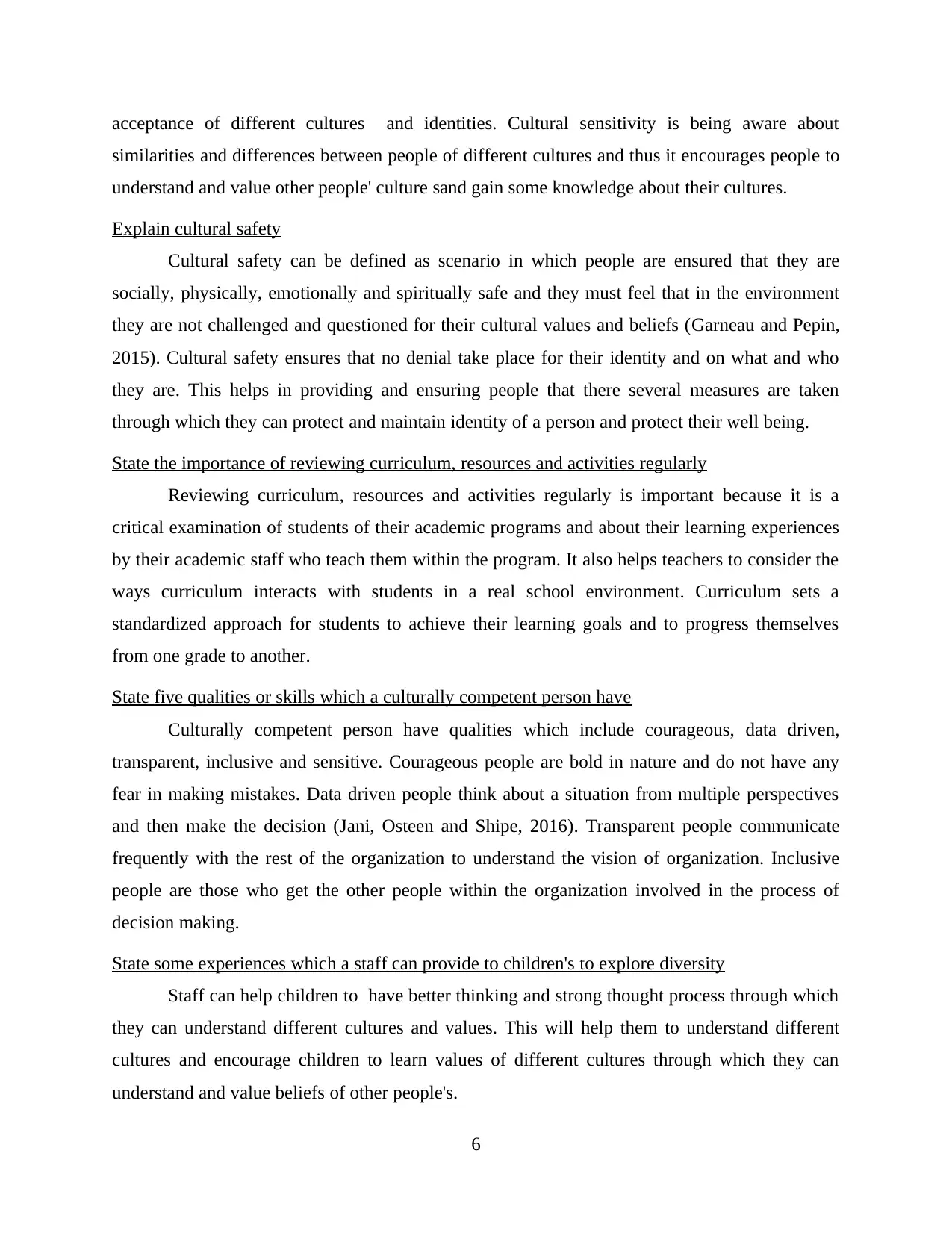
acceptance of different cultures and identities. Cultural sensitivity is being aware about
similarities and differences between people of different cultures and thus it encourages people to
understand and value other people' culture sand gain some knowledge about their cultures.
Explain cultural safety
Cultural safety can be defined as scenario in which people are ensured that they are
socially, physically, emotionally and spiritually safe and they must feel that in the environment
they are not challenged and questioned for their cultural values and beliefs (Garneau and Pepin,
2015). Cultural safety ensures that no denial take place for their identity and on what and who
they are. This helps in providing and ensuring people that there several measures are taken
through which they can protect and maintain identity of a person and protect their well being.
State the importance of reviewing curriculum, resources and activities regularly
Reviewing curriculum, resources and activities regularly is important because it is a
critical examination of students of their academic programs and about their learning experiences
by their academic staff who teach them within the program. It also helps teachers to consider the
ways curriculum interacts with students in a real school environment. Curriculum sets a
standardized approach for students to achieve their learning goals and to progress themselves
from one grade to another.
State five qualities or skills which a culturally competent person have
Culturally competent person have qualities which include courageous, data driven,
transparent, inclusive and sensitive. Courageous people are bold in nature and do not have any
fear in making mistakes. Data driven people think about a situation from multiple perspectives
and then make the decision (Jani, Osteen and Shipe, 2016). Transparent people communicate
frequently with the rest of the organization to understand the vision of organization. Inclusive
people are those who get the other people within the organization involved in the process of
decision making.
State some experiences which a staff can provide to children's to explore diversity
Staff can help children to have better thinking and strong thought process through which
they can understand different cultures and values. This will help them to understand different
cultures and encourage children to learn values of different cultures through which they can
understand and value beliefs of other people's.
6
similarities and differences between people of different cultures and thus it encourages people to
understand and value other people' culture sand gain some knowledge about their cultures.
Explain cultural safety
Cultural safety can be defined as scenario in which people are ensured that they are
socially, physically, emotionally and spiritually safe and they must feel that in the environment
they are not challenged and questioned for their cultural values and beliefs (Garneau and Pepin,
2015). Cultural safety ensures that no denial take place for their identity and on what and who
they are. This helps in providing and ensuring people that there several measures are taken
through which they can protect and maintain identity of a person and protect their well being.
State the importance of reviewing curriculum, resources and activities regularly
Reviewing curriculum, resources and activities regularly is important because it is a
critical examination of students of their academic programs and about their learning experiences
by their academic staff who teach them within the program. It also helps teachers to consider the
ways curriculum interacts with students in a real school environment. Curriculum sets a
standardized approach for students to achieve their learning goals and to progress themselves
from one grade to another.
State five qualities or skills which a culturally competent person have
Culturally competent person have qualities which include courageous, data driven,
transparent, inclusive and sensitive. Courageous people are bold in nature and do not have any
fear in making mistakes. Data driven people think about a situation from multiple perspectives
and then make the decision (Jani, Osteen and Shipe, 2016). Transparent people communicate
frequently with the rest of the organization to understand the vision of organization. Inclusive
people are those who get the other people within the organization involved in the process of
decision making.
State some experiences which a staff can provide to children's to explore diversity
Staff can help children to have better thinking and strong thought process through which
they can understand different cultures and values. This will help them to understand different
cultures and encourage children to learn values of different cultures through which they can
understand and value beliefs of other people's.
6
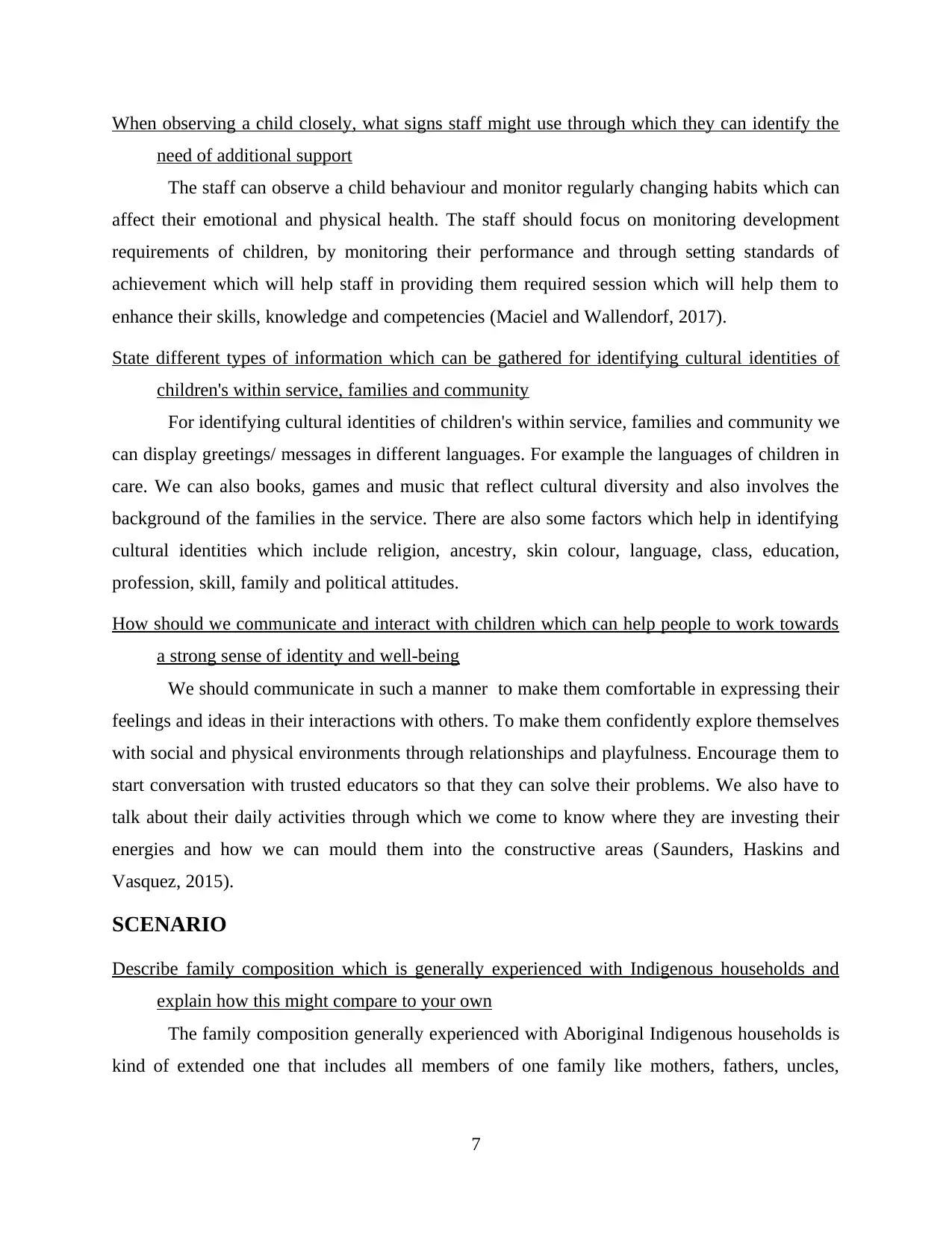
When observing a child closely, what signs staff might use through which they can identify the
need of additional support
The staff can observe a child behaviour and monitor regularly changing habits which can
affect their emotional and physical health. The staff should focus on monitoring development
requirements of children, by monitoring their performance and through setting standards of
achievement which will help staff in providing them required session which will help them to
enhance their skills, knowledge and competencies (Maciel and Wallendorf, 2017).
State different types of information which can be gathered for identifying cultural identities of
children's within service, families and community
For identifying cultural identities of children's within service, families and community we
can display greetings/ messages in different languages. For example the languages of children in
care. We can also books, games and music that reflect cultural diversity and also involves the
background of the families in the service. There are also some factors which help in identifying
cultural identities which include religion, ancestry, skin colour, language, class, education,
profession, skill, family and political attitudes.
How should we communicate and interact with children which can help people to work towards
a strong sense of identity and well-being
We should communicate in such a manner to make them comfortable in expressing their
feelings and ideas in their interactions with others. To make them confidently explore themselves
with social and physical environments through relationships and playfulness. Encourage them to
start conversation with trusted educators so that they can solve their problems. We also have to
talk about their daily activities through which we come to know where they are investing their
energies and how we can mould them into the constructive areas (Saunders, Haskins and
Vasquez, 2015).
SCENARIO
Describe family composition which is generally experienced with Indigenous households and
explain how this might compare to your own
The family composition generally experienced with Aboriginal Indigenous households is
kind of extended one that includes all members of one family like mothers, fathers, uncles,
7
need of additional support
The staff can observe a child behaviour and monitor regularly changing habits which can
affect their emotional and physical health. The staff should focus on monitoring development
requirements of children, by monitoring their performance and through setting standards of
achievement which will help staff in providing them required session which will help them to
enhance their skills, knowledge and competencies (Maciel and Wallendorf, 2017).
State different types of information which can be gathered for identifying cultural identities of
children's within service, families and community
For identifying cultural identities of children's within service, families and community we
can display greetings/ messages in different languages. For example the languages of children in
care. We can also books, games and music that reflect cultural diversity and also involves the
background of the families in the service. There are also some factors which help in identifying
cultural identities which include religion, ancestry, skin colour, language, class, education,
profession, skill, family and political attitudes.
How should we communicate and interact with children which can help people to work towards
a strong sense of identity and well-being
We should communicate in such a manner to make them comfortable in expressing their
feelings and ideas in their interactions with others. To make them confidently explore themselves
with social and physical environments through relationships and playfulness. Encourage them to
start conversation with trusted educators so that they can solve their problems. We also have to
talk about their daily activities through which we come to know where they are investing their
energies and how we can mould them into the constructive areas (Saunders, Haskins and
Vasquez, 2015).
SCENARIO
Describe family composition which is generally experienced with Indigenous households and
explain how this might compare to your own
The family composition generally experienced with Aboriginal Indigenous households is
kind of extended one that includes all members of one family like mothers, fathers, uncles,
7
Paraphrase This Document
Need a fresh take? Get an instant paraphrase of this document with our AI Paraphraser
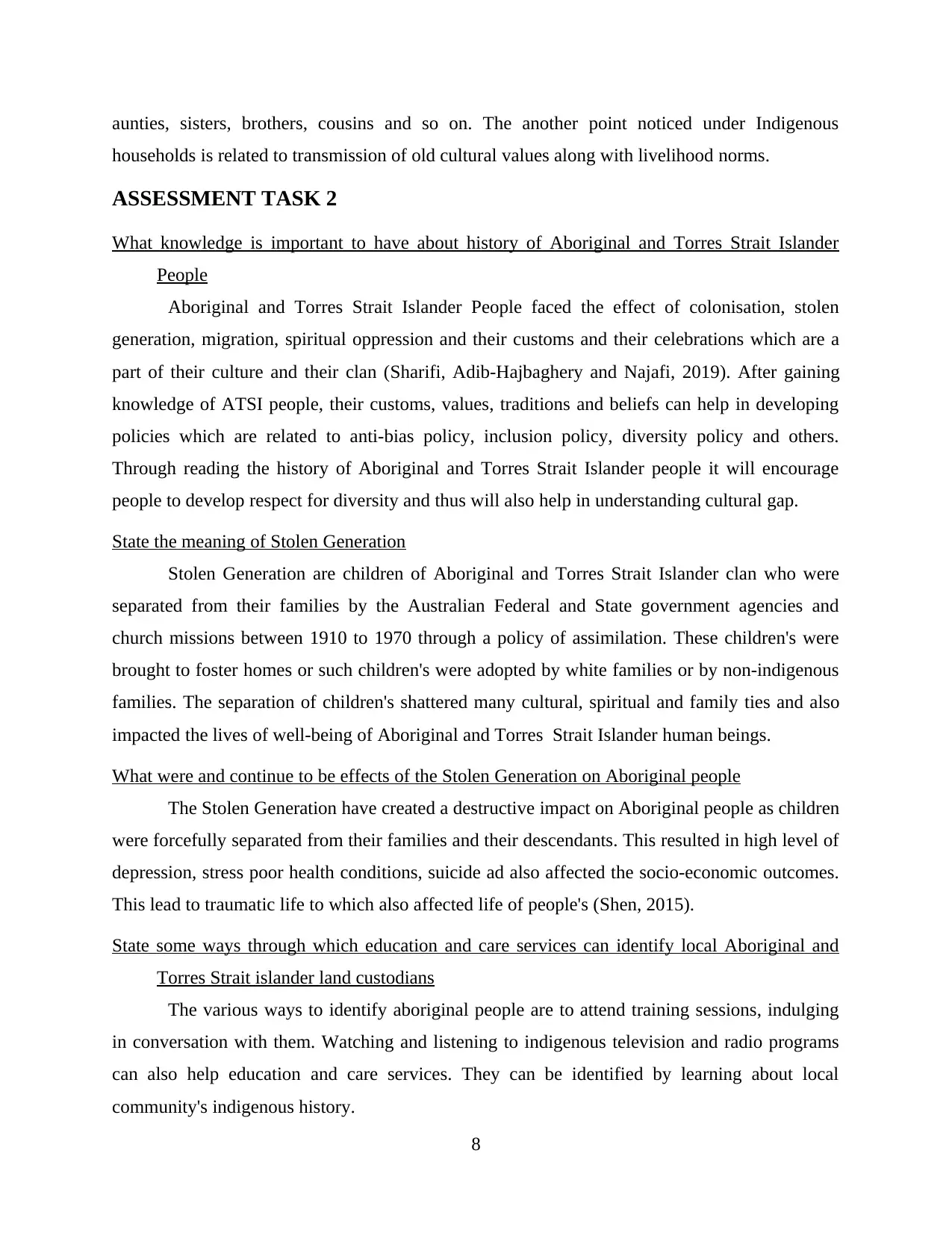
aunties, sisters, brothers, cousins and so on. The another point noticed under Indigenous
households is related to transmission of old cultural values along with livelihood norms.
ASSESSMENT TASK 2
What knowledge is important to have about history of Aboriginal and Torres Strait Islander
People
Aboriginal and Torres Strait Islander People faced the effect of colonisation, stolen
generation, migration, spiritual oppression and their customs and their celebrations which are a
part of their culture and their clan (Sharifi, Adib-Hajbaghery and Najafi, 2019). After gaining
knowledge of ATSI people, their customs, values, traditions and beliefs can help in developing
policies which are related to anti-bias policy, inclusion policy, diversity policy and others.
Through reading the history of Aboriginal and Torres Strait Islander people it will encourage
people to develop respect for diversity and thus will also help in understanding cultural gap.
State the meaning of Stolen Generation
Stolen Generation are children of Aboriginal and Torres Strait Islander clan who were
separated from their families by the Australian Federal and State government agencies and
church missions between 1910 to 1970 through a policy of assimilation. These children's were
brought to foster homes or such children's were adopted by white families or by non-indigenous
families. The separation of children's shattered many cultural, spiritual and family ties and also
impacted the lives of well-being of Aboriginal and Torres Strait Islander human beings.
What were and continue to be effects of the Stolen Generation on Aboriginal people
The Stolen Generation have created a destructive impact on Aboriginal people as children
were forcefully separated from their families and their descendants. This resulted in high level of
depression, stress poor health conditions, suicide ad also affected the socio-economic outcomes.
This lead to traumatic life to which also affected life of people's (Shen, 2015).
State some ways through which education and care services can identify local Aboriginal and
Torres Strait islander land custodians
The various ways to identify aboriginal people are to attend training sessions, indulging
in conversation with them. Watching and listening to indigenous television and radio programs
can also help education and care services. They can be identified by learning about local
community's indigenous history.
8
households is related to transmission of old cultural values along with livelihood norms.
ASSESSMENT TASK 2
What knowledge is important to have about history of Aboriginal and Torres Strait Islander
People
Aboriginal and Torres Strait Islander People faced the effect of colonisation, stolen
generation, migration, spiritual oppression and their customs and their celebrations which are a
part of their culture and their clan (Sharifi, Adib-Hajbaghery and Najafi, 2019). After gaining
knowledge of ATSI people, their customs, values, traditions and beliefs can help in developing
policies which are related to anti-bias policy, inclusion policy, diversity policy and others.
Through reading the history of Aboriginal and Torres Strait Islander people it will encourage
people to develop respect for diversity and thus will also help in understanding cultural gap.
State the meaning of Stolen Generation
Stolen Generation are children of Aboriginal and Torres Strait Islander clan who were
separated from their families by the Australian Federal and State government agencies and
church missions between 1910 to 1970 through a policy of assimilation. These children's were
brought to foster homes or such children's were adopted by white families or by non-indigenous
families. The separation of children's shattered many cultural, spiritual and family ties and also
impacted the lives of well-being of Aboriginal and Torres Strait Islander human beings.
What were and continue to be effects of the Stolen Generation on Aboriginal people
The Stolen Generation have created a destructive impact on Aboriginal people as children
were forcefully separated from their families and their descendants. This resulted in high level of
depression, stress poor health conditions, suicide ad also affected the socio-economic outcomes.
This lead to traumatic life to which also affected life of people's (Shen, 2015).
State some ways through which education and care services can identify local Aboriginal and
Torres Strait islander land custodians
The various ways to identify aboriginal people are to attend training sessions, indulging
in conversation with them. Watching and listening to indigenous television and radio programs
can also help education and care services. They can be identified by learning about local
community's indigenous history.
8
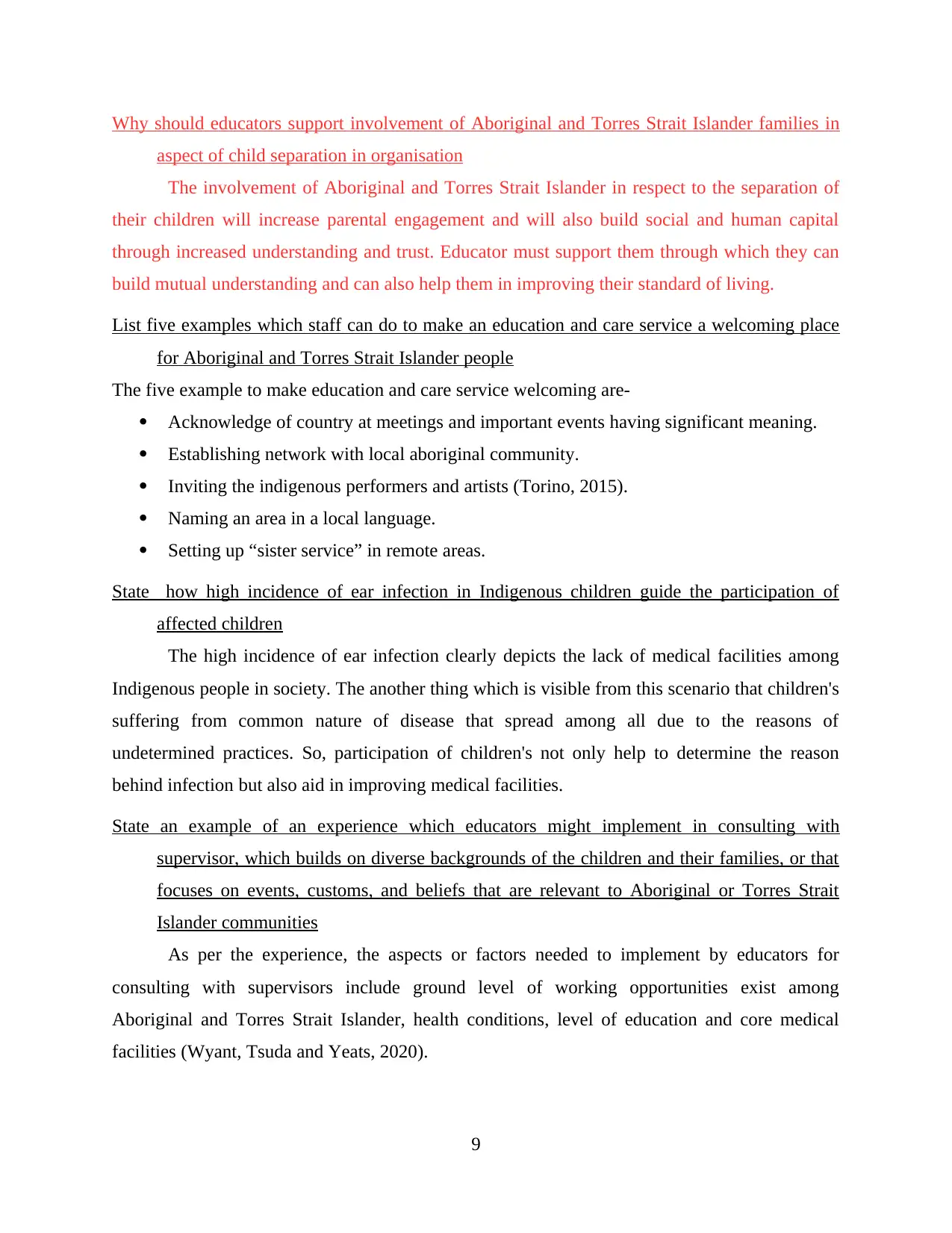
Why should educators support involvement of Aboriginal and Torres Strait Islander families in
aspect of child separation in organisation
The involvement of Aboriginal and Torres Strait Islander in respect to the separation of
their children will increase parental engagement and will also build social and human capital
through increased understanding and trust. Educator must support them through which they can
build mutual understanding and can also help them in improving their standard of living.
List five examples which staff can do to make an education and care service a welcoming place
for Aboriginal and Torres Strait Islander people
The five example to make education and care service welcoming are-
Acknowledge of country at meetings and important events having significant meaning.
Establishing network with local aboriginal community.
Inviting the indigenous performers and artists (Torino, 2015).
Naming an area in a local language.
Setting up “sister service” in remote areas.
State how high incidence of ear infection in Indigenous children guide the participation of
affected children
The high incidence of ear infection clearly depicts the lack of medical facilities among
Indigenous people in society. The another thing which is visible from this scenario that children's
suffering from common nature of disease that spread among all due to the reasons of
undetermined practices. So, participation of children's not only help to determine the reason
behind infection but also aid in improving medical facilities.
State an example of an experience which educators might implement in consulting with
supervisor, which builds on diverse backgrounds of the children and their families, or that
focuses on events, customs, and beliefs that are relevant to Aboriginal or Torres Strait
Islander communities
As per the experience, the aspects or factors needed to implement by educators for
consulting with supervisors include ground level of working opportunities exist among
Aboriginal and Torres Strait Islander, health conditions, level of education and core medical
facilities (Wyant, Tsuda and Yeats, 2020).
9
aspect of child separation in organisation
The involvement of Aboriginal and Torres Strait Islander in respect to the separation of
their children will increase parental engagement and will also build social and human capital
through increased understanding and trust. Educator must support them through which they can
build mutual understanding and can also help them in improving their standard of living.
List five examples which staff can do to make an education and care service a welcoming place
for Aboriginal and Torres Strait Islander people
The five example to make education and care service welcoming are-
Acknowledge of country at meetings and important events having significant meaning.
Establishing network with local aboriginal community.
Inviting the indigenous performers and artists (Torino, 2015).
Naming an area in a local language.
Setting up “sister service” in remote areas.
State how high incidence of ear infection in Indigenous children guide the participation of
affected children
The high incidence of ear infection clearly depicts the lack of medical facilities among
Indigenous people in society. The another thing which is visible from this scenario that children's
suffering from common nature of disease that spread among all due to the reasons of
undetermined practices. So, participation of children's not only help to determine the reason
behind infection but also aid in improving medical facilities.
State an example of an experience which educators might implement in consulting with
supervisor, which builds on diverse backgrounds of the children and their families, or that
focuses on events, customs, and beliefs that are relevant to Aboriginal or Torres Strait
Islander communities
As per the experience, the aspects or factors needed to implement by educators for
consulting with supervisors include ground level of working opportunities exist among
Aboriginal and Torres Strait Islander, health conditions, level of education and core medical
facilities (Wyant, Tsuda and Yeats, 2020).
9
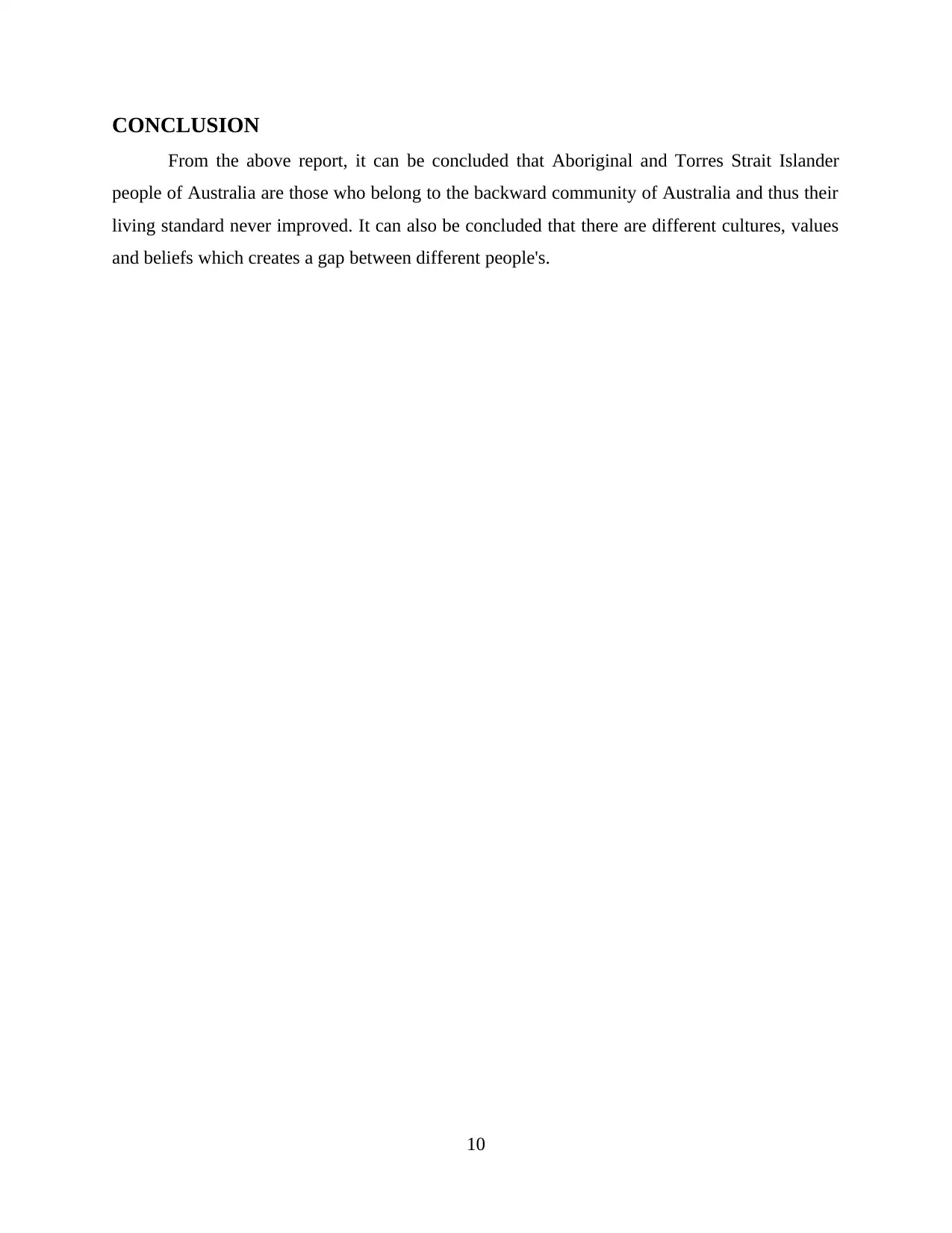
CONCLUSION
From the above report, it can be concluded that Aboriginal and Torres Strait Islander
people of Australia are those who belong to the backward community of Australia and thus their
living standard never improved. It can also be concluded that there are different cultures, values
and beliefs which creates a gap between different people's.
10
From the above report, it can be concluded that Aboriginal and Torres Strait Islander
people of Australia are those who belong to the backward community of Australia and thus their
living standard never improved. It can also be concluded that there are different cultures, values
and beliefs which creates a gap between different people's.
10
Secure Best Marks with AI Grader
Need help grading? Try our AI Grader for instant feedback on your assignments.
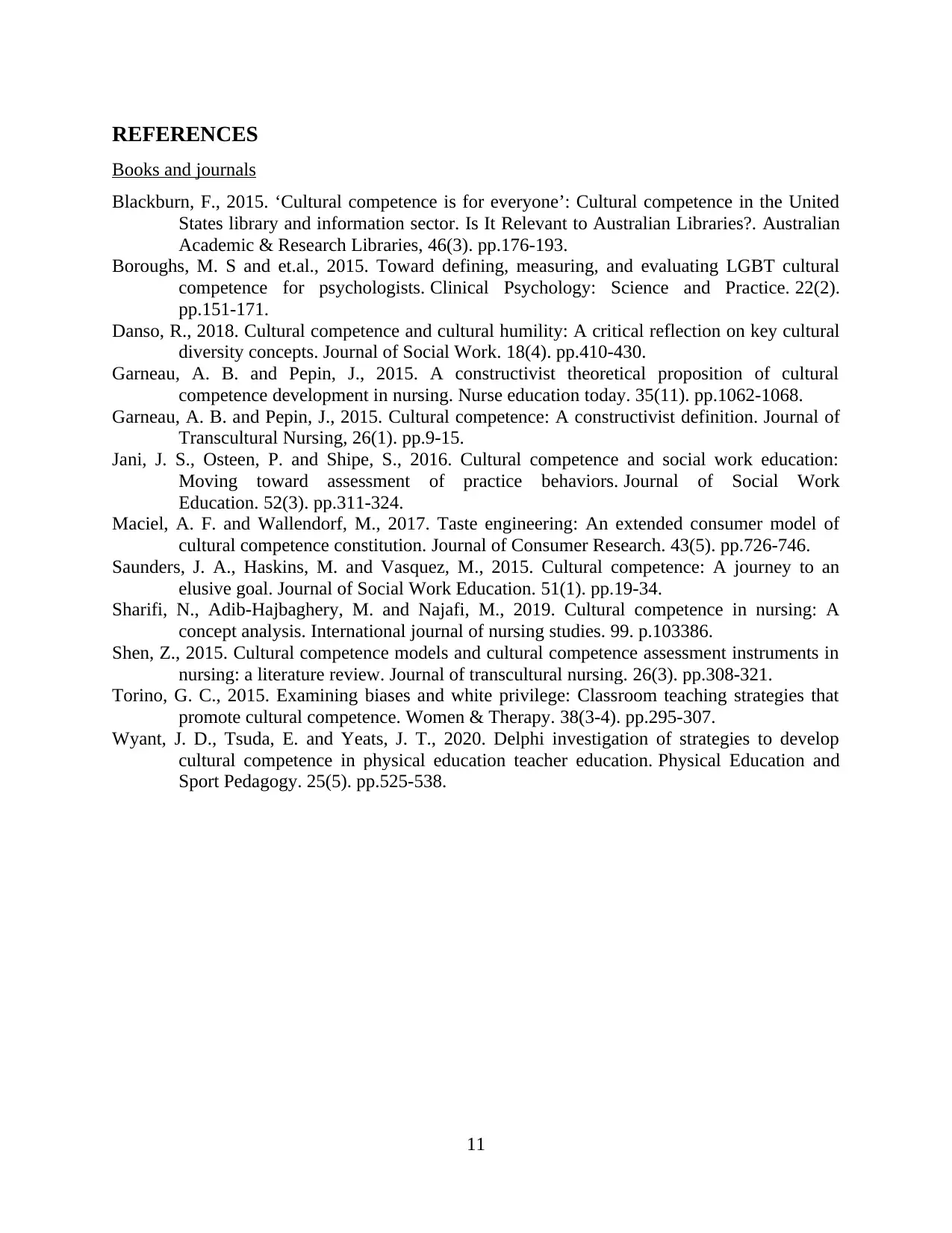
REFERENCES
Books and journals
Blackburn, F., 2015. ‘Cultural competence is for everyone’: Cultural competence in the United
States library and information sector. Is It Relevant to Australian Libraries?. Australian
Academic & Research Libraries, 46(3). pp.176-193.
Boroughs, M. S and et.al., 2015. Toward defining, measuring, and evaluating LGBT cultural
competence for psychologists. Clinical Psychology: Science and Practice. 22(2).
pp.151-171.
Danso, R., 2018. Cultural competence and cultural humility: A critical reflection on key cultural
diversity concepts. Journal of Social Work. 18(4). pp.410-430.
Garneau, A. B. and Pepin, J., 2015. A constructivist theoretical proposition of cultural
competence development in nursing. Nurse education today. 35(11). pp.1062-1068.
Garneau, A. B. and Pepin, J., 2015. Cultural competence: A constructivist definition. Journal of
Transcultural Nursing, 26(1). pp.9-15.
Jani, J. S., Osteen, P. and Shipe, S., 2016. Cultural competence and social work education:
Moving toward assessment of practice behaviors. Journal of Social Work
Education. 52(3). pp.311-324.
Maciel, A. F. and Wallendorf, M., 2017. Taste engineering: An extended consumer model of
cultural competence constitution. Journal of Consumer Research. 43(5). pp.726-746.
Saunders, J. A., Haskins, M. and Vasquez, M., 2015. Cultural competence: A journey to an
elusive goal. Journal of Social Work Education. 51(1). pp.19-34.
Sharifi, N., Adib-Hajbaghery, M. and Najafi, M., 2019. Cultural competence in nursing: A
concept analysis. International journal of nursing studies. 99. p.103386.
Shen, Z., 2015. Cultural competence models and cultural competence assessment instruments in
nursing: a literature review. Journal of transcultural nursing. 26(3). pp.308-321.
Torino, G. C., 2015. Examining biases and white privilege: Classroom teaching strategies that
promote cultural competence. Women & Therapy. 38(3-4). pp.295-307.
Wyant, J. D., Tsuda, E. and Yeats, J. T., 2020. Delphi investigation of strategies to develop
cultural competence in physical education teacher education. Physical Education and
Sport Pedagogy. 25(5). pp.525-538.
11
Books and journals
Blackburn, F., 2015. ‘Cultural competence is for everyone’: Cultural competence in the United
States library and information sector. Is It Relevant to Australian Libraries?. Australian
Academic & Research Libraries, 46(3). pp.176-193.
Boroughs, M. S and et.al., 2015. Toward defining, measuring, and evaluating LGBT cultural
competence for psychologists. Clinical Psychology: Science and Practice. 22(2).
pp.151-171.
Danso, R., 2018. Cultural competence and cultural humility: A critical reflection on key cultural
diversity concepts. Journal of Social Work. 18(4). pp.410-430.
Garneau, A. B. and Pepin, J., 2015. A constructivist theoretical proposition of cultural
competence development in nursing. Nurse education today. 35(11). pp.1062-1068.
Garneau, A. B. and Pepin, J., 2015. Cultural competence: A constructivist definition. Journal of
Transcultural Nursing, 26(1). pp.9-15.
Jani, J. S., Osteen, P. and Shipe, S., 2016. Cultural competence and social work education:
Moving toward assessment of practice behaviors. Journal of Social Work
Education. 52(3). pp.311-324.
Maciel, A. F. and Wallendorf, M., 2017. Taste engineering: An extended consumer model of
cultural competence constitution. Journal of Consumer Research. 43(5). pp.726-746.
Saunders, J. A., Haskins, M. and Vasquez, M., 2015. Cultural competence: A journey to an
elusive goal. Journal of Social Work Education. 51(1). pp.19-34.
Sharifi, N., Adib-Hajbaghery, M. and Najafi, M., 2019. Cultural competence in nursing: A
concept analysis. International journal of nursing studies. 99. p.103386.
Shen, Z., 2015. Cultural competence models and cultural competence assessment instruments in
nursing: a literature review. Journal of transcultural nursing. 26(3). pp.308-321.
Torino, G. C., 2015. Examining biases and white privilege: Classroom teaching strategies that
promote cultural competence. Women & Therapy. 38(3-4). pp.295-307.
Wyant, J. D., Tsuda, E. and Yeats, J. T., 2020. Delphi investigation of strategies to develop
cultural competence in physical education teacher education. Physical Education and
Sport Pedagogy. 25(5). pp.525-538.
11
1 out of 11
Related Documents
Your All-in-One AI-Powered Toolkit for Academic Success.
+13062052269
info@desklib.com
Available 24*7 on WhatsApp / Email
![[object Object]](/_next/static/media/star-bottom.7253800d.svg)
Unlock your academic potential
© 2024 | Zucol Services PVT LTD | All rights reserved.





